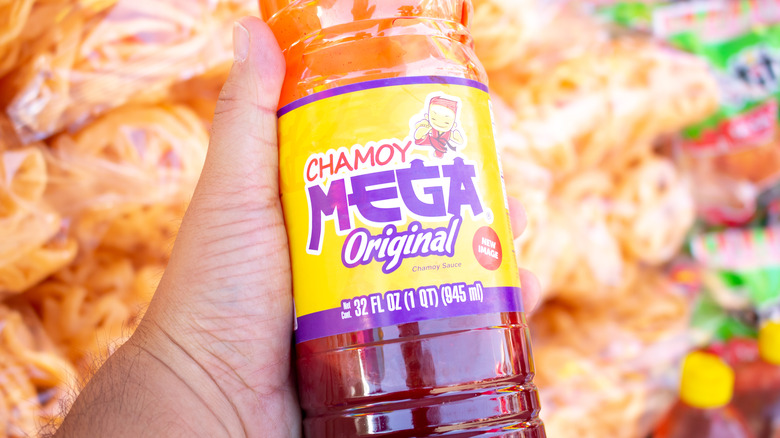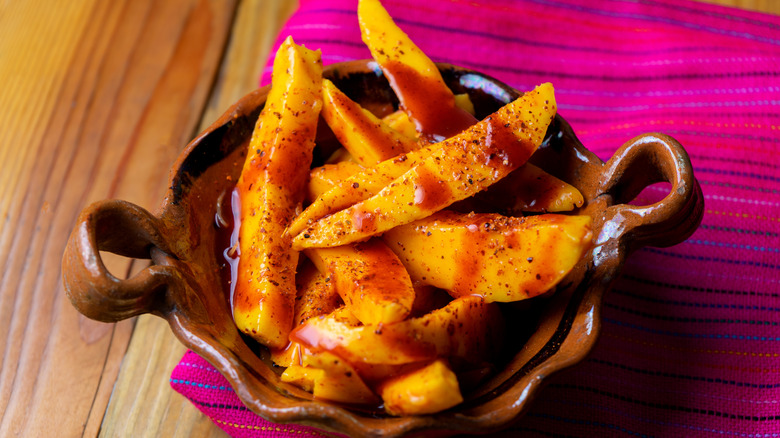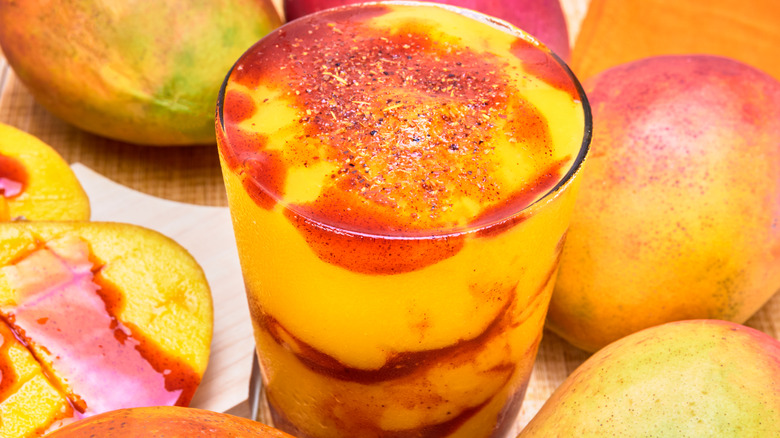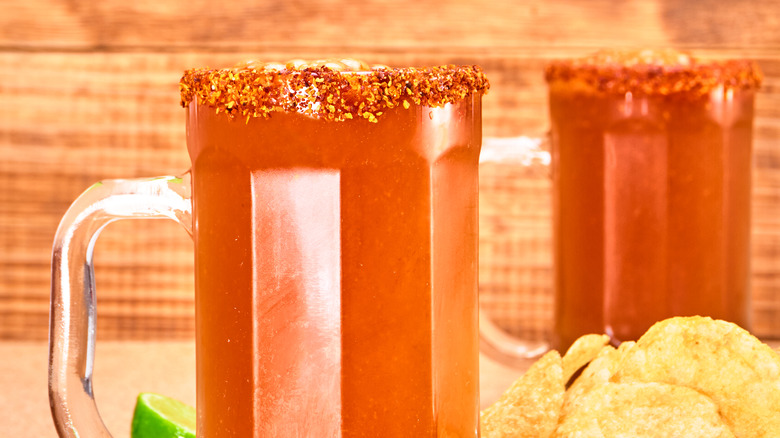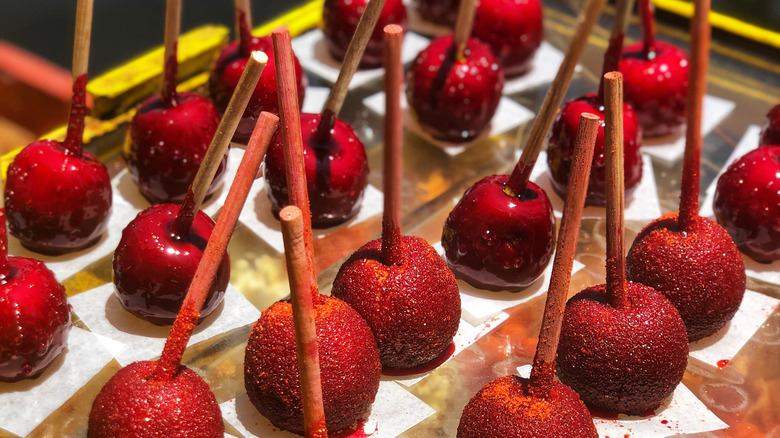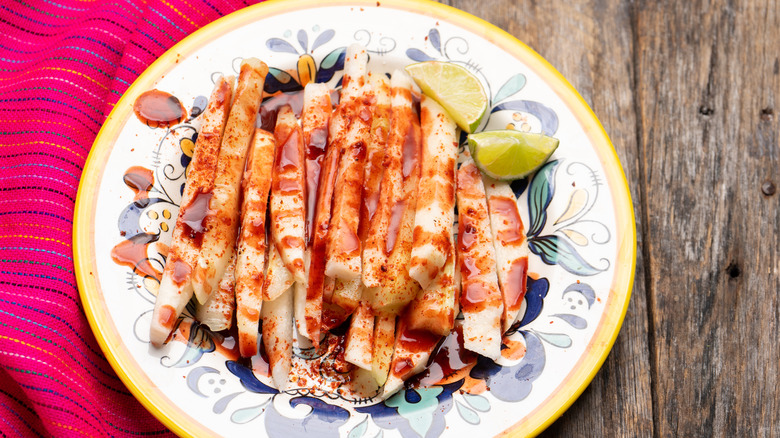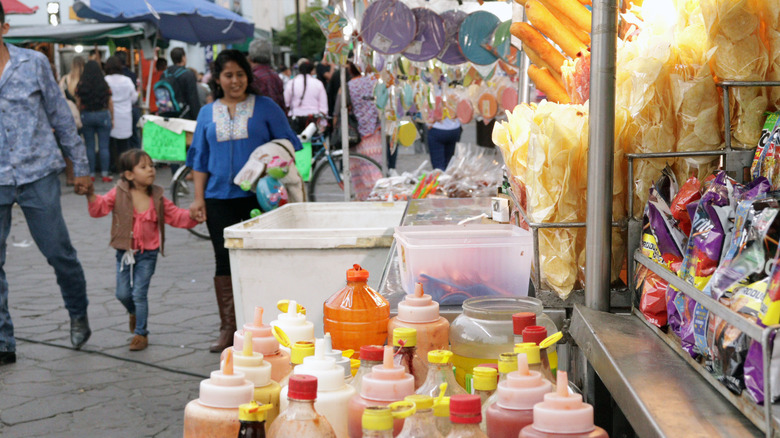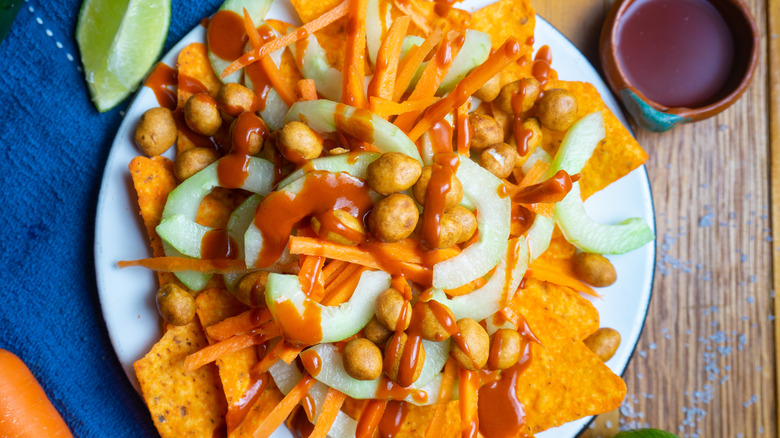What Is Chamoy And What Does It Taste Like?
On a hot summer day, you're craving a delectable treat that you can savor that will also revitalize you. Imagine stopping at a street food cart on the side of a bustling city street, the smells of tamales and elote wafting around you. Hankering for something a bit lighter, you opt for the fresh mango slices with a bright red sauce. The combination of flavors invigorates your mouth: sweet, salty, spicy, and tangy. The sauce definitely takes this snack to the next level.
Ah, chamoy. For anyone who has never tasted it before, the first bite of a snack covered in chamoy sauce will shock and then delight the tastebuds with its distinctive and bold flavor. It's common to see chamoy covering fruit or coating the rim of a cocktail glass. For lovers of Mexican street food, chamoy is a vital ingredient that contributes so much kick to the dish that it completely transforms the experience.
What is chamoy?
Chamoy is a Mexican condiment that is extremely popular. It's practically a staple of Mexican kitchens and is as ubiquitous as peanut butter in the United States. Nowadays, people living in Mexico grow up eating chamoy as a sauce for fruits and an ingredient in candy, but the savory food originally comes from China. According to food historian Rachel Laudan, chamoy didn't become popular in Mexico until the 1990s (via NPR).
It first came to Mexico as the Chinese dish see mui, or salted and dried apricots. Starting in the 1500s, Asian merchants brought silk and spices to Mexico, and many who immigrated to the country brought an influx of food and culture, including the preserved plums that served as a precursor to chamoy. It slowly integrated into Mexican culture until companies started mass-producing it. The company Dulces Miguelito began manufacturing and selling chamoy sauce in 1971 and chamoy candy powder in 1973. Since then, it has skyrocketed in popularity and the company's chamoy products are still top sellers, according to Taste. Now, the nostalgia for chamoy is bringing it to the culinary forefront internationally.
How is chamoy made?
Chamoy is made out of salted, dried fruit. It traditionally derives from ume plums (which are actually small sour apricots) but is also known to be made from other fruits like sour green mangoes or tamarind pods, and is then mixed with chiles to give it its trademark spicy flavor (via NPR).
The original method for making chamoy uses the fruit as a base to be used for other products. The salted dried fruit is typically blended into a thick sauce that is a bright red color. The dried fruit itself can be ground up into a powder as well. Other seasonings can be added at this stage to create different undertones to the flavor, including lime juice and chili powder. These two products are ultimately used to season other food or as a condiment.
Commercially produced chamoy products have strayed from the traditional method, and will often be made with chemicals, high fructose corn syrup, and flavoring like citric acid, as Eater reports.
Chamoy sauce vs. powder
While chamoy is usually used as a sauce to drizzle over a dish, it can also be used as a powder. The same taste is achieved, but sometimes a powder is more convenient than the condiment, sauce, or syrup that usually comes to mind.
A common way to use chamoy is as a hot sauce. When used this way, you can add the tangy-sweet spice to any dish you desire. Tajiín makes a special fruity hot sauce that tastes like its classic chile and lime seasoning with a hint of apricot that is just what your tastebuds crave (via Tajín).
The sauce form is often favored and is most widely available. However, the powdered version of chamoy is better when you want to add dashes of the flavor to the rim of a cocktail glass, keep the mess down when pinching onto fresh fruit, or want to include it in a seasoning mix for a new chamoy-infused dish. Chamoy powder is available for purchase for these needs. Candy chamoy powder is also a fan favorite.
What does chamoy taste like?
Sour, salty, spicy, sweet: Chamoy is so unique because it captures an all-inclusive flavor profile that tastes like sunlight in your mouth. But don't just take our word for it!
The chef at La Palapa in New York City, Barbara Sibley, described the flavor to Eater as "all the flavors at once — sweet, sour, salty, spicy, and a little umami" while she reminisced on her Mexico City childhood eating chamoy candies before the market was infiltrated by American brands. Another chef, Dominica Salomon at Cosecha in Oakland, asserted that chamoy has "all of the different taste buds going off at the same time" in a distinct, Mexican way (via NPR).
The unique and powerful flavor is extremely popular in Mexico, and is beginning to be used more in culinary kitchens to flavor cocktails, beer, pickles, wings, and other dishes in the United States. The kick of chamoy is sure to add an extra oomph of flavor in any way that it's used.
How to cook with chamoy
There are a few ways chamoy is traditionally used. The way it is used in cooking depends on the form of chamoy you have acquired. It can come wet or dry in its dried fruit form, which can be eaten straight without any modifications as a delicious snack. This form of chamoy is called saladito, and is available with other types of Mexican candies (via Mex Grocer). Other chamoy candies include syrups that can be mixed with shaved ice or beverages (via Taste).
Commonly, chamoy is purchased as a hot sauce in a bottle. This sauce can be added on top of fresh fruit to add an extra kick. It's popularly drizzled on chips. Eater says chamoy can be mixed with corn, cream, cheese, mayonnaise, and chili powder to make heighten the Mexican street food esquites.
True chamoy lovers will even eat syrupy sauce alone as a sugary treat. Chef Barbara Sibley of La Palapa in New York fondly remembers eating it straight until her teeth "felt like they were going to fall out," as she told Eater.
Chefs across the United States have started using chamoy sauce in innovative ways, such as cooking it into a glaze for barbecue or tacos. These innovations open the door for chamoy sauce to be used in any dish that needs a sweet but spicy, tangy taste.
Where to buy chamoy
In most places, it won't be hard to purchase chamoy if you'd like to start using it in your kitchen. If your local grocery store has an aisle of Mexican goods and foods, chamoy will almost certainly be stocked there. You can also visit any specialty Mexican grocery store for a wider selection of chamoy options. The condiment is also available to be ordered online at specialty food outlets and Amazon. It will be easiest to find chamoy sauce sold in bottles, but there may also be a selection of candies with chamoy on the ingredient list or the whole dried fruit sold as a snack.
Making your own chamoy using a homemade recipe is also an option, and will give you the most control over the flavors and taste. Sour fruits like apricots or plums are good to use as the base for homemade chamoy, and all the ingredients you need can be found in any grocery store (via Muy Delish).
Nutritional information about chamoy
While it is delicious, nobody asserts that chamoy is a health food item. When using it as a hot sauce or condiment, it won't make up the bulk of a dish. In Mexico, chamoy is considered junk food. Most of the commercially produced chamoy is full of high-fructose corn syrup and preservatives. It typically doesn't contain real fruit, but will have citric acid to achieve the tart flavor, according to Eater. Fooducate says that one tablespoon of Miguelito Chamoy Powder Mix contains 30 calories, 540 mg of sodium, and 8 grams of sugar.
Silvana Salcido Esparza, chef and owner of the Bario Cafe in Pheonix, told NPR that she loves to hate chamoy and claimed it "is making Mexico the most diabetic country in the world" along with other popular snack foods. She advocates for more natural homemade chamoy.
Chamoy is also vegan, as it uses no animal products. Homemade chamoy is of course a more nutritious option than sweet, commercially produced chamoy as you have more control over the base ingredients and production method (via Muy Delish).
